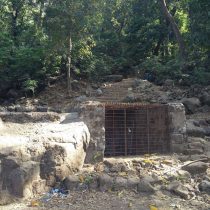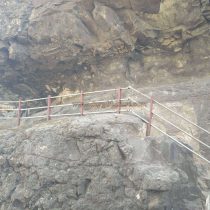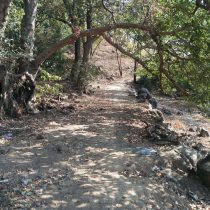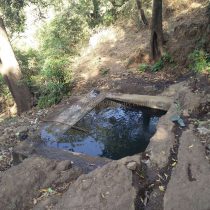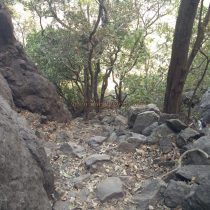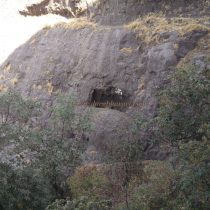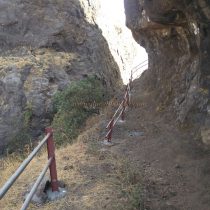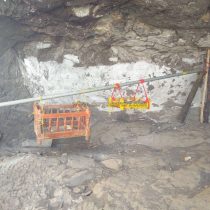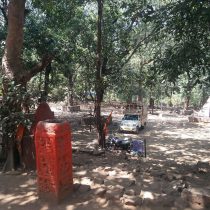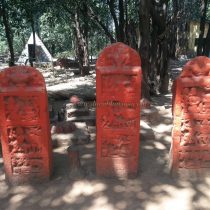AAJOBA
TYPE : HILL FORT
DISTRICT : THANE
HEIGHT : 2690 FEET
GRADE : MEDIUM
Shahapur taluka in Thane district is famous for its one day trek from Mumbai-Thane. Mahuli, Bhandardurg, Sandhan Valley, Karolighat, Bansulka, Ajobagad are located here. Most of the time these places are populated by the tourists. To reach all the other places except Mahuli-Bhandardurg, one has to reach the village dehane at the foot of this place. To reach Ajobagad also known as Ajaparvat first way is Mumbai-Thane-Asanagava-Shahapur-Dolakhamba-Sakurli-Dehane and the second is Mumbai-Thane- Kalyan-Murbad-Malasej-Dolakhamba-Sakurli-Dehane. The distance of the first way is 114 km and the second way is 125 km. By this route, we can only reach till the machi of the fort and if you want to reach the peak of this fort you have to reach Kumsheth village via Kasara-Ghoti-Rajur road.
...
This distance is 210 km from MMumbai. This fort is spread in the east-west direction and from the top of this fort, we can see far wide although there are no historical artifacts. People doubt if this is a fort or not. This is because, apart from a tank carved in the rock, there are no traces of fortifications like bastions or ramparts, also this fort is not mentioned anywhere in history. The origin of the name of the fort “Aajoba’’ is directly related to the Ramayana period. Valmiki sage wrote Ramayana on this place and Sitamai gave birth to Luv - Kush here. The story is told by the locals that the fort was named Ajobagad as Luv – Kush referred Valmiki sage as their grandfather. To reach the plateau below Aajoba fort there is a paved road which will take you to the foothill of the fort i.e. to the raw road which leads to Valmiki Ashram. This road is about 4km and this distance is to be covered walking. In an hour you will reach near Valmiki Ashram. Before entering the forest in the vicinity of the ashram, a small waterfall can be seen on the left side of the road. The ashram premises are densely forested and the trees here are newly built with stone crosses. Here is a simple Samadhi temple built and the Samadhi inside it is considered to be of Valmiki sage. There are four hero stones over here out of which one is carved from all 4 sides and the remaining ones are carved only from 1 side. One of them is Dhenugal. Ten stones of different shapes & sizes and paduka carvings can be seen in this neighborhood. Besides the stairs, a symbolic stone of Goddess installed in a small dome. To the left of the Samadhi temple, there is fort’s old ashram and to the right, there are two small temples. The temple with the shivling in the deep temple should be the former water tank. Stairs are built to descend into this tank. The second temple is of recent date and has some idols. The condition of the Dharamshala built here for the Devotees of the Ashram is devastating due to dust and litter. If you want to stay here, you can stay at the Ashram besides the Samadhi temple, up to 20 people can easily take shelter here. The quiet and peaceful climate in the area around the Ashram is littered by the tourists who visit here. In front of the Samadhi temple, one of the steps leads down to a tank of water. There is spring near this tank which flows throughout the year. This water is drinkable and is used for many purposes. Excess water flowing through this spring is stored in another tank on the next slope. You can fill up your water bottles and come back to Samadhi temple. Behind the Ashram, to the left of Samadhi temple, there is a path that leads you to the front side of the fort to Sitamai’s cradle. This is an unpaved route is also a path for water that comes from the top of the fort there is a straight climb from here and in approximately 1 or 1½ hour you will reach Sitamai’s cradle in the gorge between the two hills. There is no chance of getting lost as directional arrows are painted on the rocks at various places along the way. When you come to the gorge, the wind coming up from the valley removes all your fatigue. The right side of the gorge has a natural cave that can seat 25-30 people and steps are built to enter the cave. In this cave, two small wooden cradles are built on a pillar. For safety, iron walls have been erected on the path of the cave, steps, and cones. There are rectangular water tanks carve in the rock on the road in front of the cave and currently, these tanks are dry. The path leading from this tank turns to the cone and goes to the back of the cave. From where this path ends, there is a path leading to the cone. This path is to go to the top of the cone and it is dangerous to go up this path without knowing the techniques of mountaineering and the equipment. There is a small cave with two small water tanks in the hill in front of the cave with the cradles. This cave is man-made and has an iron ladder to enter it. Below the cone which has cradle Dehene village can be seen below whereas Sandhan Valley, Karoli Ghat, and Ratangad to the front and right sides. After returning to the ashram, your trek to the fort is complete. Four hours is enough to walk around the entire fort. Indeed this is not a fort, but just a watchtower built to keep an eye on Karoli Ghat. At the present history of the fort is unknown.
© Suresh Nimbalkar

